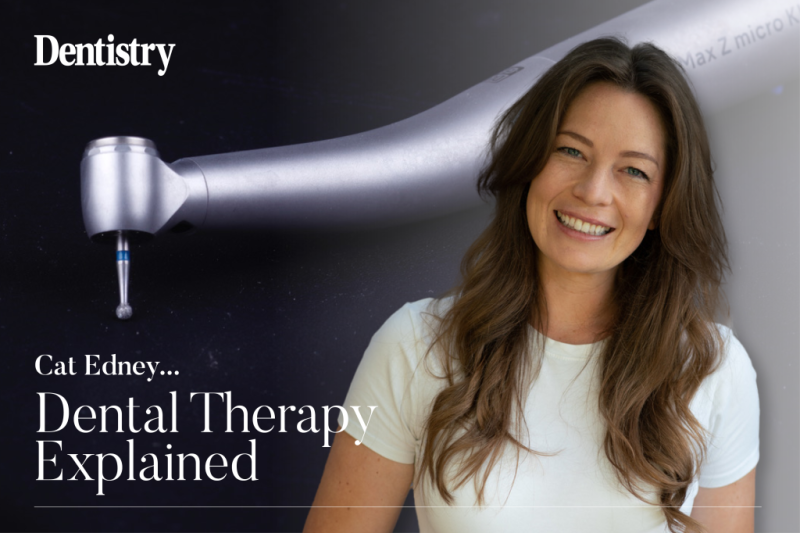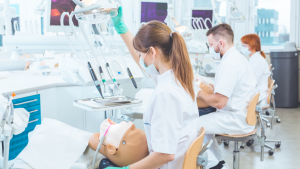What can dental therapists do now? – an update

Cat Edney explores how the role of dental therapists have evolved and their impact on modern dentistry.
The role of dental therapy has been an ever evolving one, and we have seen much development in the last few years in terms of progression, integration and utilisation.
In addition to changes in legislation, there have been changes in workforce acceptance and also in public perception.
I wanted to dedicate this month’s column to the incredible opportunity we see now for the use of dental therapists across both private and NHS sectors, focusing on the three key changes we have seen that have pushed dental therapy into the spotlight.
So, what has changed?
Direct access
I know it’s an oldie, but it’s a goody and it is a subject that is still so little understood by the wider team. Therefore, it is important to mention the introduction of direct access as that was the catalyst that started off much progression for dental therapists.
The changes came about in 2013 following a review into access to dental care by the Office of Fair Trading which concluded that it was in the public interest to allow patients to see dental hygienists, dental therapists and, in some cases, clinical dental technicians directly, without the need for a referral or treatment prescription from a dentist.
What does this mean?
Patients can visit a dental therapist for all the care they are able to provide under their scope of practice, as outlined in the General Dental Council (GDC) scope of practice document. This means dental therapists can examine, diagnose, plan (and deliver) the care for their patients.
Crucially, they can now see patients at the start of a clinical journey rather than only having patients referred to them.
Of course, prior to any treatment, patients should have an examination and diagnosis process and should have time to ensure they understand their treatment options and can give informed consent – but all of this process can be delivered by their dental therapist.
The ability to examine, diagnose and plan care for patients was a huge step for dental therapists. However, it was not without complications: the use of prescription only medications such as local anaesthetics and prescription strength fluoride was still regulated by the human medicines act, and therefore could only be prescribed by the dentists within the team.
This saw the introduction of the Patient Group Direction (PGD) documentation that allows the supply and administration of specific prescription only medication. Companies such as Dentaldirectives were quick to provide invaluable support to the professions, allowing direct access to be a viable option and providing practices with a new way of team working.
NHS FP17 forms
In October 2022, the NHS FP17 form was adapted, allowing dental therapists and dental hygienists to add their GDC number and open and close an NHS course of treatment in England. This change came about as part of an NHS England initiative to support skills mix and provide better access to care.
The FP17 form had been a barrier to dental therapists providing direct access care within the NHS. The later addition of a personal number ensures DCPs providing this service have a means of tracking their contribution.
However, this still falls short of the rights given to dentists by means of a performer number – which allows dentists to access pension contributions.
What does this mean?
Regardless of the way a patient is paying for their dentistry, they can now see a dental therapist directly, without having to see a dentist first. This should provide better access to care within NHS settings and, in theory, somewhat ease the pressure on NHS dental services.
A dental therapist can open a course of treatment using their personal number, provide an examination and all direct restorative work required. If a patient needs work that is out of a dental therapist’s scope, the course of treatment is jointly opened with the dentist’s performer number and the dental therapist’s personal number, and a shared care arrangement is pursued.
There is still further work to be done to ensure a smooth and profitable patient journey within the NHS structure. For example, training on understanding delivery of care, phased courses of treatment and what treatment is available to NHS patients.
In addition, further training and knowledge on the Index of Orthodontic Treatment Need (IOTN) classification should be considered to ensure timely referrals for paediatric patients.
The ability to support NHS practices in the delivery of NHS contracts has been a big move forwards for dental therapists, seeing more teams interested in skills mix and becoming more open to a shared care arrangement.
However, there is still the issue of medicine prescribing – with PGDs unobtainable within the NHS structure due to the nature of their development (the ICB needs to sign these off, and as yet this is not a common occurrence) careful consideration has been needed to ensure dental therapists work within the current legislations.
Exemption Legislation
In the background of the above changes has been a quiet hum of activity. There has been a number of hard-working individuals pushing to change the restrictions placed on dental therapists and hygienists in regards to the supply and administration of local anaesthetics and prescription strength fluoride.
This barrier to prescribing was due to the Human Medicines Act, first introduced in 1968 and then updated in 2012. At the time, dental therapists and hygienists were not included in the 2012 exemptions framework that saw professionals such as nurses and pharmacists able to prescribe a number of named medications.
This will be in part because direct access had not yet been introduced in 2012, and so dentists were still expected to oversee, refer and prescribe all treatments required.
The relentless work of our associations and a number of key stake holders has meant that, following a consultation period and extensive impact assessment, exemptions legislation has been passed.
As a result, this allows dental therapists and hygienists who have undertaken the appropriate framework training to now administer local anaesthetic, fluoride and topical nystatin.
What does this mean?
At the time of writing, NHS England (NHSE) have still not unveiled their training programme for dental therapists and hygienists who wish to work within the exemptions framework.
For this reason, there can be no change as yet.
However, the training is expected to be announced soon and it has been suggested that NHSE have worked hard to ensure it is the appropriate training for a group of professionals that have already been administering these medications under Patient Group Directives. Therefore, it should be relatively straight forward to access and complete.
It is expected that Scotland and Northern Ireland will follow suit with framework training programmes too.
What can a 2024 dental Therapist do?
Once trained, dental therapists who wish to will be able to take on full responsibility for delivering direct preventative, periodontal and restorative care to their patients.
From providing examinations, to planning the delivery of care and delivering all direct restorative work, dental therapists will be able to undertake full care for paediatric patients. This includes providing extractions and pulp therapy on deciduous teeth and, once trained, making timely orthodontic referrals.
In addition to private practice, they will be able to support the delivery of NHS contracts and expand the access to care for patients throughout England.
Practices that wish to fully utilise the skillset of their dental therapists will be able to with far less red tape, less pressure on the dentists within the team and more of a seamless patient journey.
I also hope that this means more dental therapists will consider returning to using their full scope of practice.
Catch up with Cat’s previous columns:
Follow Dentistry.co.uk on Instagram to keep up with all the latest dental news and trends.







